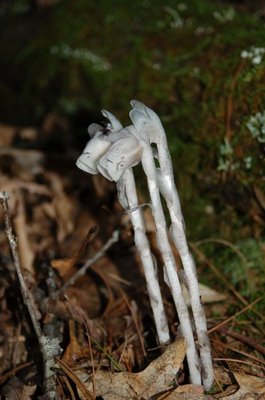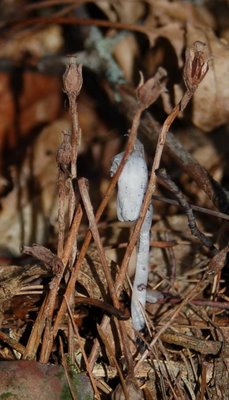
I thought these strange, subterranean plants would be a fitting topic for All Hallows Day, and that was before I remembered that "ghost flower" and "corpse plant" are alternative names. I've never heard anyone call them anything but "Indian pipe," but they are disquieting without the ghoulish monickers. What would possess a group of ericaceous plants to go underground, to live on mycelium, to dwell in eternal darkness? When I first heard of Baudelaire, these were the flowers of evil I pictured.
I wanted to check my taxonomic facts before I blogged. I remembered Lawrence's Taxonomy of Vascular Plants placed Indian pipe in Pyrolaceae, along with pipsissiwa, pyrola, and American wintergreen. My venerable field guides concurred, but I seemed to remember someone placing all the Pyrolaceae in the Ericaceae (heathers, rhododendrons, azaleas, blueberries). The seed capsules of the previous year's Indian pipe (below) do remind me of wintergreen, azalea, and mountain laurel capsules. Dead and dessicated, Indian pipe looks much less ghostly.

The Internet has frustrated me in my taxonomic inquiries. The Integrated Taxonomic Information Service places Monotropa uniflora in the Monotropaceae. All the strange, subterranean parasites are related to each other, but this classification gives no clue to their nearest green relations. The ITIS is not at all forthcoming about when and where this new family assignment was published, if, indeed, it is new, and not a throwback to some nineteenth century botanical splitter.
Still, I did find some interesting information about Indian pipes, which I present for your approval.
- Monotropa uniflora, the ghost plant on Tom Volk's Fungi.net, has a consise explanation of Indian pipe's strange symbiosis.
...all of the monotropes are parasitic on fungi! These fungi are mycorrhizal with photosynthetic trees, and thus the energy ultimately comes from photosynthesis of the tree, passing through the mycorrhizal fungus on the way to the Monotropa.
The tree, already providing energy to the fungus, is probably physiologically 'unaware' of the additional loss of carbon and it is likely that it is the fungus that controls the passage of carbon to Monotropa....
- Wildflowers of North Carolina's Indian pipe page includes a Cherokee legend (told with a hint of condescension, yet interesting enough to quote here):
Before selfishness came into the world-that was a long time ago- the Cherokee people were happy sharing the hunting and fishing places with their neighbors. All this changed when Selfishness came into the world and man began to quarrel. The Cherokee quarreled with tribes on the east. Finally the chiefs of several tribes met in council to try to settle the dispute. They smoked the pipe and continued to quarrel for seven days and seven nights. This displeased the Great Spirit because people are not supposed to smoke the pipe until they make peace. As he looked upon the old men with heads bowed, he decided to do something to remind people to smoke the pipe only at the time they make peace.
The Great Spirit turned the old men into greyish flowers we now call "Indian Pipes" and he made them grow where friends and relatives have quarreled. He made the smoke hang over these mountains until all the people all over the world learn to live together in peace.
told by Mary Chiltosky in the book, Cherokee Plants...
- Keith Dawson's page on Indian pipes, recounts some medicinal uses explaining alternative names for the plant.
He credits Hedgemaids and Fairy Candles: The Lives and Lore of North American Wildflowers, (Jack Sanders, 1993) for this information.The plant's flesh turns black when cut or even bruised. It also oozes a clear, gelatinous substance when picked or wounded. Such unattractive characteristics have earned the Indian pipe some unflattering names, like ghost flower and corpse plant. Indians employed it as an eye lotion -- whence the name, eyebright -- as well as for colds and fevers. Americans of the last century treated spasms, fainting spells, and nervous conditions with it -- thus the names convulsionroot, fitroot, and convulsionweed.
- Indian Springs Herbal Encyclopedia lists these medicinal uses:
Maddeningly, I found these same words on several other Web sites. No one gave attribution, and all claimed global copyrights. Tsk, tsk.American Indians used plant juice for inflamed eyes, bunions, and warts; drank tea for aches and pains due to colds. Root tea used for convulsions, fits, epilepsy; sedative. Physicians once used tea as antispasmodic, nervine, sedative for restlessness, pains, nervous irritability. As a folk remedy for sore eyes, the plant was soaked in rose water, then a cloth was soaked in the mixture and applied to the eyes. Water extracts are bactericidal.
Warning! Safety undetermined; possibly toxic -- contains several glycosides.
No comments:
Post a Comment